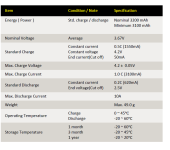Hello everyone,
I have a problem, I need to select a BMS discharge overcurrent and discharge current but I do not know how to chose this BMS parameteraccording to the cell and the moter ? Any one has a tips how to calculate discharge overcurrent and discharge for the BMS.
Which theory expalin this ? any reference , paper, course explain this choice of the value discharge overcurrent and discharge current.
Thank you,
Kind regards,
rand
I have a problem, I need to select a BMS discharge overcurrent and discharge current but I do not know how to chose this BMS parameteraccording to the cell and the moter ? Any one has a tips how to calculate discharge overcurrent and discharge for the BMS.
Which theory expalin this ? any reference , paper, course explain this choice of the value discharge overcurrent and discharge current.
Thank you,
Kind regards,
rand


